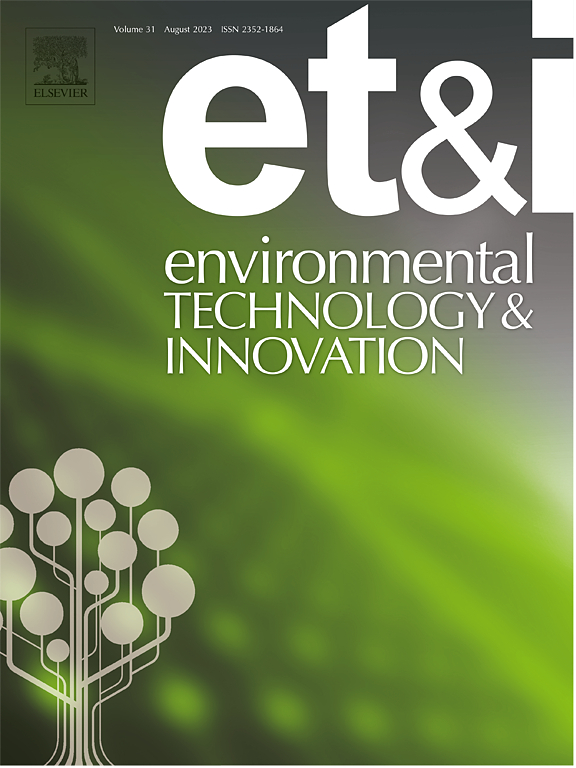Immobilization of fungal laccase onto red seaweed biomass as a novel support for efficient dye decolorization
IF 6.7
2区 环境科学与生态学
Q1 BIOTECHNOLOGY & APPLIED MICROBIOLOGY
引用次数: 0
Abstract
In this study, the indigenous white rot fungal strain Hebeloma sp. YZH2 was isolated and identified based on the 18S rRNA gene sequencing technique. This fungal strain was used for laccase production under submerged fermentation of wheat bran. The produced crude fungal laccase was immobilized onto Gracilaria, which was used as a novel support matrix for laccase immobilization for the first time. The fungal laccase immobilized on Gracilaria (LIG) was then applied for the decolorization of the textile azo dye Eriochrome Black T (EBT) from aqueous solutions. LIG was further optimized to achieve maximum dye decolorization through response surface methodology using the Box- Behnken design (BBD). The results indicated that the fungal strain Hebeloma sp. YZH2 exhibited high laccase production under submerged fermentation of wheat bran and laccase activity reached a peak of 293.8 U/mL after 26 days of incubation. Laccase was successfully immobilized onto Gracilaria biomass by adsorption method followed by precipitation and cross-linking. The maximum immobilized laccase activity of 199.3 U/g was observed at 200 U/mL, 5 %, 2 h and 10 mM for laccase concentration, Gracilaria concentration, cross- linking time, and glutaraldehyde concentration, respectively. LIG showed high thermal stability, retaining 31 % relative activity at 80°C, while free laccase completely lost its activity. It also showed better pH stability compared to free laccase. Based on BBD results, the maximum predicted EBT decolorization efficiency (99.27 %) was achieved at pH 4.04, agitation speed of 159.29 rpm and biomass dose of 9.84 g/L.
真菌漆酶固定化在红海藻生物量上作为一种高效染料脱色的新载体
本研究利用18S rRNA基因测序技术,分离并鉴定了本地白腐真菌Hebeloma sp. YZH2。该菌株用于麦麸深层发酵生产漆酶。将合成的真菌粗漆酶固定化在江蓠上,首次将江蓠作为固定化漆酶的新型载体基质。将固定化真菌漆酶应用于对纺织偶氮染料Eriochrome Black T (EBT)的脱色。利用Box- Behnken设计(BBD)响应面法对LIG进行进一步优化,以达到最大的染料脱色效果。结果表明,真菌Hebeloma sp. YZH2在麦麸深层发酵条件下具有较高的漆酶产量,培养26 d后漆酶活性达到293.8 U/mL的峰值。采用吸附-沉淀-交联的方法成功地将漆酶固定在江蓠生物量上。漆酶浓度为200 U/mL、5 %、2 h和10 mM时,漆酶活性最高,分别为199.3 U/g、5 %、2 h和5 mM。LIG表现出较高的热稳定性,在80℃时保持31% %的相对活性,而游离漆酶完全失去活性。与游离漆酶相比,其pH稳定性更好。结果表明,在pH为4.04、搅拌速度为159.29 rpm、生物质投加量为9.84 g/L的条件下,EBT脱色效率达到99.27 %。
本文章由计算机程序翻译,如有差异,请以英文原文为准。
求助全文
约1分钟内获得全文
求助全文
来源期刊

Environmental Technology & Innovation
Environmental Science-General Environmental Science
CiteScore
14.00
自引率
4.20%
发文量
435
审稿时长
74 days
期刊介绍:
Environmental Technology & Innovation adopts a challenge-oriented approach to solutions by integrating natural sciences to promote a sustainable future. The journal aims to foster the creation and development of innovative products, technologies, and ideas that enhance the environment, with impacts across soil, air, water, and food in rural and urban areas.
As a platform for disseminating scientific evidence for environmental protection and sustainable development, the journal emphasizes fundamental science, methodologies, tools, techniques, and policy considerations. It emphasizes the importance of science and technology in environmental benefits, including smarter, cleaner technologies for environmental protection, more efficient resource processing methods, and the evidence supporting their effectiveness.
 求助内容:
求助内容: 应助结果提醒方式:
应助结果提醒方式:


